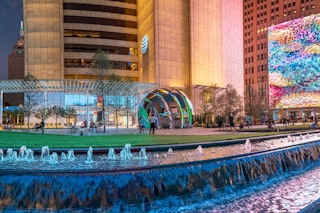Art Park
Move over Miami, Fair Park is a Texas-sized Art Deco destination.
What is the first thing that pops into your head as soon as you hear the words Fair Park? If you answered the State Fair of Texas, you are not alone. The 277-acre park just east of Downtown is well-known for greeting millions of visitors during the State Fair of Texas. However, to the astonishment of many corny-dog loving, Big Tex waving, deep-fried-everything-eating Dallasites, Fair Park is a world renown for a completely different reason - its architecture. In fact, the fairgrounds is a historic architectural goldmine placing Fair Park along Miami's South Beach as an Art Deco Icon.
A Texanic Affair
It all started in 1936 when state officials chose Dallas as the site of the Texas Centennial Exposition to celebrate the state's 100 year anniversary of its independence from Mexico. The then governor of Texas wanted the exposition to be a "Texanic" (or gigantic in non-Texan terms) affair. In order to do so, Dallas needed to spruce up its humble fairgrounds at Fair Park. Local architect George Dahl was responsible for designing more than 50 Art Deco-style buildings. Dahl embraced modernism in his designs in order to enhance Dallas's image as a modern, forward-thinking city.
In addition to the buildings, artists from around the world created murals, sculptures, mosaics and other works of art that celebrated the achievements of Texas' first 100 years. More than 30 of those original buildings still stand, providing Dallas with the largest concentration of 1930s-era buildings and public art in the United States.
Esplanade Fountain
The Perry Avenue entrance on the park's western edge was Fair Park's original main entrance in 1886. Today, visitors can still enter the park here stepping off the DART rail instead of the city's original trolley car. After walking through the entrance gates, visitors are met with the park's crown jewel - the grand esplanade. The 700-foot long reflection pool is capped with three fountains. Hundreds of water jets propel water out of the pool putting on regular shows to songs like, "The Yellow Rose of Texas."
On the left side of the esplanade is Centennial Hall, covered with large murals depicting the various modes of transportation in the 1930s. On the right side of the esplanade is the Automotive Building with its murals depicting the industries of the day like iron factories and oil derricks. The murals use Art Deco details such as bold geometric patterns vibrant, contrasting colors and illustrations of bare-breasted women and muscular men.
Larger-than-life stone sculptures stand along both the right and left sides of the esplanade facing the fountain. Each one depicts one of the six nations once ruled over Texas. The statue that represents France holds grapes while the Republic of Texas statue holds cotton flowers.
Hall of State
A long walk down the esplanade ends at a shrine to Texas. Explosion officials built the elaborate Hall of State building to showcase the state's economic, agricultural, and social developments. Unlike other park buildings that were made from concrete, the Hall of State was built from Texas limestone. In fact, all the material used in construction was from Texas.
The Hall of State is considered to be one of the best examples of Art Deco architecture in Texas. Grand 76-foot tall limestone pillars frame the bronze double doors. Look closely at the bronze doors and you will see an ode to one of Texas's most profitable industries - an oil derrick. Atop the entrance stands the gold Tejas Warrior statue. The man representing a member of the indigenous tribe of Texas holds a bow up to the sky with one hand. The lack of an arrow in the other hand symbolizes peace. The blue mosaic behind him represents the fields of bluebonnets that Texas is famous for.
Step inside the cathedral-like building and the first thing one notices is the massive gold medallion on the back wall. Like the status along the esplanade, the gold-leaf medallion symbolizes the six nations that once held sovereignty over Texas. Painted along the 46-foot walls are Eugene Savage's murals detailing Texas history from the arrival of the Europeans in the 1500s through 1936.
For a more in-depth guide to the art and architecture of Fair Park check out the Dallas Center for Architecture which hosts free Fair Park tram tours several times throughout the year and the self-guided tour on the Friends of Fair Park website and app.
The Fair Park grounds are open daily from 6 a.m. to 10 p.m. Check their website to plan your adventure!
More Like This











